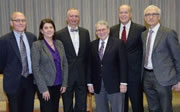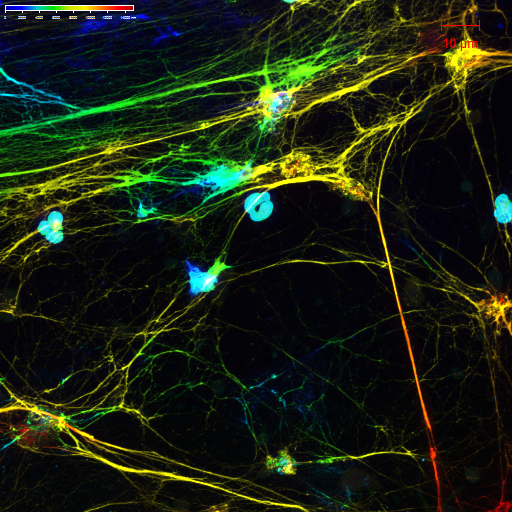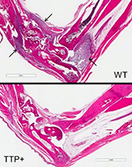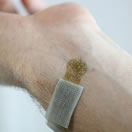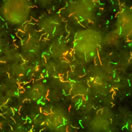Spotlight
Letter from Dr. Stephen I. Katz: Enhancing Support for Early-Career Stage Clinician Scientists
Dear Colleagues,
As Director of the NIAMS, one of my most important responsibilities is to foster the next generation of biomedical researchers. Over the past several years, the National Institutes of Health (NIH) and the NIAMS have taken a number of steps to support early-stage investigators, notably clinician scientists, who face unique challenges in pursuing research careers.
Image: Stephen I. Katz, M.D., Ph.D.
News
Four Named to NIAMS Advisory Council
The NIAMS has appointed four new members to its advisory council. The council comprises scientific and lay members who have expertise in the mission areas of the Institute. Council members provide advice to the Institute on broad policy issues and make recommendations on research proposals.
Image: NIAMS Director Dr. Stephen Katz (third from r) and Deputy Director Dr. Robert Carter (third from l) welcome new council members. Pictured are (from l) Dr. Stephen Tapscott, Magdalena Castro-Lewis, William Mulvihill and Dr. Ethan Lerner. Photo credit: Ernie Branson.
2017 NIAMS Congressional Justification Now Available
The Congressional Justification submitted by the NIAMS complements the President's budget request by explaining the Institute's mission, highlighting recent research accomplishments and future initiatives, and providing comparative budget data for the previous, current and upcoming fiscal years. Brief descriptions of the Institute's Extramural and Intramural Research Programs are also included, along with overviews of key research support activities. Additionally, a series of Program Portraits are included that highlight accomplishments and future directions of selected activities funded by the Institute.
Dog with Duchenne Muscular Dystrophy Escapes the Disease, Spurring Interest in Potential New Treatment Approach
The NIAMS has appointed four new members to its advisory council. The council comprises scientific and lay members who have expertise in the mission areas of the Institute. Council members provide advice to the Institute on broad policy issues and make recommendations on research proposals.
Image: NIAMS Director Dr. Stephen Katz (third from r) and Deputy Director Dr. Robert Carter (third from l) welcome new council members. Pictured are (from l) Dr. Stephen Tapscott, Magdalena Castro-Lewis, William Mulvihill and Dr. Ethan Lerner. Photo credit: Ernie Branson.
Mitochondria Found To Play Instrumental Role in NET Formation and Autoimmune Disease
Neutrophil extracellular traps (NETs) are web-like structures that immune cells, called neutrophils, use to ensnare and kill microbes, such as bacteria or fungi. Normally, NETs are released in response to invading pathogens, but the traps have also been associated with autoimmune diseases, such as systemic lupus erythematosus. Researchers in the NIAMS Intramural Research Program have uncovered a role for mitochondria, the cell’s power producers, in the release of NETs and the development of autoimmune diseases.
Image: NET formation from a type of neutrophil called a low-density granulocyte. Photo credit: Mariana Kaplan, M.D., and Luz Blanco, Ph.D., NIAMS.
Natural Protein Points to New Inflammation Treatment: Findings May Offer Insight to Effective Treatments for Inflammatory Diseases, Such as Rheumatoid Arthritis, Psoriasis and Multiple Sclerosis
Increasing the level of a naturally produced protein, called tristetraprolin (TTP), significantly reduced or protected mice from inflammation, according to researchers at the NIH. The results suggest that pharmaceutical compounds or other therapeutic methods that produce elevated levels of TTP in humans may offer an effective treatment for some inflammatory diseases, such as rheumatoid arthritis, psoriasis and multiple sclerosis.
Image: Stained sections of foot joints from wild-type (top) and TTP+ (bottom) mice show that when both were tested using a model of rheumatoid arthritis, the wild-type mouse experienced significant inflammation, as shown by arrows. Photo credit: National Institute of Environmental Health Sciences (NIEHS).
NIH Scientists Discover Genetic Cause of Rare Allergy to Vibration
Scientists at the NIH have identified a genetic mutation responsible for a rare form of inherited hives induced by vibration, also known as vibratory urticaria. By studying affected families, researchers discovered how vibration promotes the release of inflammatory chemicals from the immune system’s mast cells, causing hives and other allergic symptoms.
NIBIB Researchers Help Design and Test Blood-Flow Sensor for Vascular Disease Monitoring
Frequent measurement of blood flow changes could improve the ability of health care providers to diagnose and treat patients with vascular conditions, such as those associated with diabetes and high blood pressure. In addition to diabetes and chronic hypertension, conditions that affect the health of blood vessels and surrounding tissue include kidney disease, autoimmune diseases and other inflammatory conditions.
New Material Developed for Accelerated Skin Regeneration in Major Wounds
Some skin wounds, such as diabetic ulcers, are chronic and may never heal; others, such as burn wounds, are often large and difficult to treat, resulting in pain, infection and scarring. Researchers at the University of California, Los Angeles have developed a synthetic biomaterial that fills wounds and aids in regeneration of skin cells, which ultimately improves wound healing.
NIH Director’s Blog
Snapshots of Life: Stronger Than It Looks
If you went out and asked folks what they’re seeing in this picture, most would probably guess an elegantly woven basket or a soft, downy feather. But what this scanning electron micrograph from Olivier Duverger, Ph.D., and Maria Morasso, Ph.D., of the NIAMS actually shows isn’t at all soft: it is the hardest substance in the mammalian body—tooth enamel!
Lyme Disease: Gene Signatures May Catch the Infection Sooner
A research team supported by the NIAMS and the National Heart, Lung, and Blood Institute (NHLBI) recently uncovered a unique gene expression pattern in white blood cells from people infected with the Lyme disease-causing bacterium Borrelia burgdorferi. This distinctive early gene signature, which persists after antibiotic treatment, is unique from other viral and bacterial illnesses studies by the team. With further work and validation, the test could one day possibly provide a valuable new tool to help doctors diagnose Lyme disease earlier and help more people get the timely treatment that they need.
Image: Immunofluorescent antibodies bind to surface proteins on the bacterium that causes Lyme disease, producing fluorescent yellow, red and green hues. Photo credit: National Institute of Allergy and Infectious Diseases (NIAID).
Other Federal News
CDC Public Health Grand Rounds: Chronic Fatigue Syndrome: Advancing Research and Clinical Education
In this videotaped session of the Centers for Disease Control and Prevention’s Public Health Grand Rounds, an expert panel of clinicians, epidemiologists and researchers discuss how they approach diagnosis and treatment, how the diagnostic criteria for chronic fatigue syndrome have changed over the years and how the public health community can continue to improve knowledge and understanding of this complex disorder.
NEW PUBLICATIONS AND PRODUCTS
Spotlight on Scientific Imagery: Oxidative Stress Caused by Mitochondrial ROS in Low-Density Granulocytes
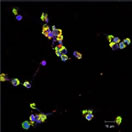
Molecules known as reactive oxygen species (ROS) are produced in the mitochondria, the energy factories of the cells. These molecules can cause oxidative stress in neutrophils, a type of white blood cell. This oxidative stress is enhanced in a type of neutrophil detected in patients with lupus, called low-density granulocytes. This oxidative stress can lead to the abnormal immune response and autoimmunity seen in patients with lupus. In the image, mitochondrial reactive oxygen species is red, mitochondrial protein is green and DNA is blue. This image is courtesy of Luz Blanco, Ph.D., and Mariana Kaplan, M.D., of the NIAMS Systemic Autoimmunity Branch, and is in the public domain.
New Resource: NIH Health Information Newsletter
Sign up to receive the NIH Health Information newsletter and get email updates twice a month about healthy living and wellness from across the NIH.
NIH Research Matters
NIH Research Matters is a review of NIH research from the Office of Communications and Public Liaison, Office of the Director, NIH.
NIH News in Health
Read practical health information in NIH News in Health, which is reviewed by the NIH’s medical experts and is based on research conducted either by the NIH’s own scientists or by its grantees at universities and medical schools around the country.
Help for Rare and Undiagnosed Conditions
Trying to get a diagnosis for a perplexing medical condition can be a long and frustrating process. For rare diseases, a diagnosis may take years. The NIH’s Genetic and Rare Diseases (GARD) Information Center features information about thousands of rare diseases as well as resources to help with diagnoses and finding appropriate care.
MEETINGS
FDA Public Workshop: Navigating the Center for Drug Evaluation and Research: What You Should Know for Effective Engagement
Thursday, March, 31, 2016
8:30 a.m. to 5 p.m.
Location: FDA White Oak Campus,10903 New Hampshire Ave, Silver Spring, MD 20993
Registration is required.
The full agenda and information on how to access the Webcast will be posted approximately five days before the meeting. For additional information, please contact Shawn Brooks at [email protected] or 240-402-6509.
Symposium: Understanding the Sex Bias in Disease
Monday, April 18, 2016
NIH Campus
Building 10, Lipsett Amphitheater
8:30 a.m. to 4:30 p.m.
A meeting agenda is available.
Registration is here.
NIH Wednesday Afternoon Lecture Series
The NIH’s Wednesday Afternoon Lecture Series offers weekly lectures every Wednesday at 3 p.m. in Masur Auditorium, Building 10, NIH Campus. Renowned scientists from around the globe present research on a variety of topics. The lectures are Continuing Medical Education-certified, open to the public and available live via webcast.
Upcoming Lecture:
April 6, 2016
Amita Sehgal, Ph.D., University of Pennsylvania Perelman School of Medicine
“A Daily Period of Unproductivity: Can We Solve the Mystery of Sleep?”
NIH Science Lectures and Events Available via Internet
The NIH hosts a number of science seminars and events that are available online through real-time streaming video. You can watch an event at your convenience as an on-demand video or a downloadable podcast. Most events are available to all; a few are broadcast for NIH or the U.S. Department of Health and Human Services and are marked as such. See additional details on events.
FUNDING ANNOUNCEMENTS
NIAMS ANNOUNCEMENTS
Mechanistic Ancillary Studies to Ongoing Interventional Clinical Trials (R01)
(RFA-AR-17-003)
Letter of Intent Receipt Dates: 30 days prior to application due dates
Application Receipt Dates: August 9, 2016; December 5, 2016; and April 3, 2017
Mechanistic Ancillary Studies to Ongoing Interventional Clinical Trials (R21)
(RFA-AR-17-004)
Letter of Intent Receipt Dates: 30 days prior to application due dates
Application Receipt Dates: August 9, 2016; December 5, 2016; and April 3, 2017
Building Complex 3-Dimensional in Vitro Human Musculoskeletal and Skin Tissue Models (R43)
(RFA-AR-17-005)
Letter of Intent Receipt Date: September 18, 2016
Application Receipt Date: October 18, 2016
Basic Biopsychosocial Mechanisms and Processes in the Management of Chronic Conditions (R21)
(PAR-16-095)
Letter of Intent Receipt Date: November 6, 2016
Application Receipt Date: December 6, 2016
Accelerating Research on Intervertebral Disc (ARID) (R21)
(PA-16-096)
Letter of Intent Receipt Dates: Not applicable
Application Receipt Dates: Standard dates apply
Accelerating Research on Intervertebral Disc (ARID) (R01)
(PA-16-097)
Letter of Intent Receipt Dates: Not applicable
Application Receipt Dates: Standard dates apply
NIH COMMON FUND INITIATIVE ANNOUNCEMENTS
Pre-application: Stimulating Peripheral Activity To Relieve Conditions (SPARC): Technologies To Understand the Control of Organ Function by the Peripheral Nervous System (OT1)
(RFA-RM-16-002)
Letter of Intent Receipt Date: Not applicable
Application Receipt Dates: March 11, 2016, and May 16, 2016
Limited Competition - Stimulating Peripheral Activity to Relieve Conditions (SPARC): Technologies to Understand the Control of Organ Function by the Peripheral Nervous System (OT2)
(RFA-RM-16-003)
Letter of Intent Receipt Date: Not applicable
Application Receipt Date: New and Resubmission applications are accepted on the date specified in the Invitation to Submit after successful competition of the corresponding OT1 application (See RFA-RM-16-002)
Stimulating Peripheral Activity to Relieve Conditions (SPARC): Pre-clinical Development of Existing Market-approved Devices to Support New Market Indications (U18)
(RFA-RM-16-009)
Letter of Intent Receipt Date: April 2, 2016
Application Receipt Date: May 2, 2016
OTHER FUNDING ANNOUNCEMENTS
NIH Policy on Informed Consent for Human Fetal Tissue Research
(NOT-OD-16-033)
NIH Fiscal Policy for Grant Awards - FY 2016
(NOT-OD-16-046)
Ruth L. Kirschstein National Research Service Award (NRSA) Stipends, Tuition/Fees and Other Budgetary Levels Effective for Fiscal Year 2016
(NOT-OD-16-047)
Clarification: New Salary and Research Cost Allowances for K08 and K23 Career Development Awards
(NOT-OD-16-054)
Change in eRA Commons Registration Process
(NOT-OD-16-056)
Streamlining the eRA Commons Registration Process
(NOT-OD-16-057)
Reminder: NIH and AHRQ Grant Application Changes for Due Dates On or After January 25, 2016
(NOT-OD-16-058)
Notice of Correction to Salary Limitation on NIH Grants, and Cooperative Agreements
(NOT-OD-16-059)
Notice of Participation of the Office of AIDS Research in PAR-16-028 "HIV/AIDS Vaccine Scholars Program (K01)"
(NOT-OD-16-060)
Revised: Ruth L. Kirschstein National Research Service Award (NRSA) Stipends, Tuition/Fees and Other Budgetary Levels Effective for Fiscal Year 2016
(NOT-OD-16-062)
Registration Now Open for the Spring and Fall 2016 NIH Regional Seminars on Program Funding and Grants Administration
(NOT-OD-16-065)
Reminder: All Subject Inventions Must Be Reported on the HHS 568 - Final Invention Statement and Certification (For Grant or Award) and in iEdison
(NOT-OD-16-066)
Plan to Move to Updated Forms (FORMS-D) for Administrative Supplement, Successor-In-Interest and Change of Institution Opportunities
(NOT-OD-16-068)
Notice of Intent to Publish a Funding Opportunity Announcement for Bioengineering Research Grants (BRG) (R01)
(NOT-EB-16-001)
PAR-12-200 NIOSH Small Research Grant Program (R03): Musculoskeletal Health Research Priorities
(NOT-OH-16-011)
PAR-12-252 NIOSH Exploratory/Developmental Research Grant Program (R21): Musculoskeletal Health Research Priorities
(NOT-OH-16-012)
PAR-13-129 Occupational Safety and Health Research (R01): Musculoskeletal Health Research Priorities
(NOT-OH-16-013)


